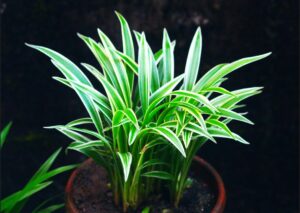Climbing houseplants can change a plain wall into a living design. Their vines move gently, bringing life and calm into any room. These plants do more than fill space-they create comfort. Their green leaves soften hard edges, cover blank corners, and build natural beauty.
Many indoor climbers, like pothos and philodendron, grow well with little care. They work in both large homes and small flats. People love them because they take up less floor space. You can let them trail down from shelves or guide them up walls.
But safety is a concern for many. Are climbing houseplants safe to keep indoors? That question matters if you live with pets or children. Some plants may be toxic. Others may cause allergies or damage walls. Picking the right plant and caring for it well makes a big difference.
This guide helps you explore indoor climbers with safety in mind. It covers safe choices, toxic risks, and smart growing tips. If you want to enjoy green vines without fear, keep reading. Your dream indoor jungle can also be a safe one.
Benefits of Climbing Plants in a Home
Make Small Spaces Feel Larger
Climbing plants grow up instead of out. They save floor space and add height to the room. You can hang them near windows, place them on tall shelves, or guide them along walls. A narrow hallway or tight living room feels bigger when your eyes follow a green trail upward. This simple trick makes the room feel open without adding clutter.
Create a Calm Mood
Green leaves help calm the mind. Their soft shapes and quiet colors slow you down. A vine on the wall breaks up hard lines and blocks harsh light. This creates a gentle space that feels cozy. You start to relax when you see natural patterns. Even a single plant can turn a cold room into a warm one. The quiet beauty of vines builds comfort and peace.
Freshen the Air
Some climbing houseplants clean the air. They trap dust and may remove toxins like formaldehyde or benzene. These chemicals come from paint, plastic, or furniture. The leaves and roots filter them out. The room smells fresher and feels lighter. Cleaner air helps you breathe with ease. You may sleep better and feel less tired during the day. Spider plants and pothos are good choices for this.
Add Life Without Extra Work
Many indoor vines grow fast with little effort. You do not need to water every day or move them often. These plants adapt well to indoor light and need only basic care. You clip back long stems and wipe dust when needed. That keeps the plant healthy and your space tidy. A few minutes each week gives long-lasting beauty.
Boost Style in Every Room
Climbing plants fit any style. They blend with wood, metal, or glass. They soften modern edges and add charm to classic spaces. You can shape them to match your taste. Let them grow wild or keep them trimmed. Use them as living art. Their color and form add texture, depth, and warmth to your home.
What Are Climbing Houseplants?
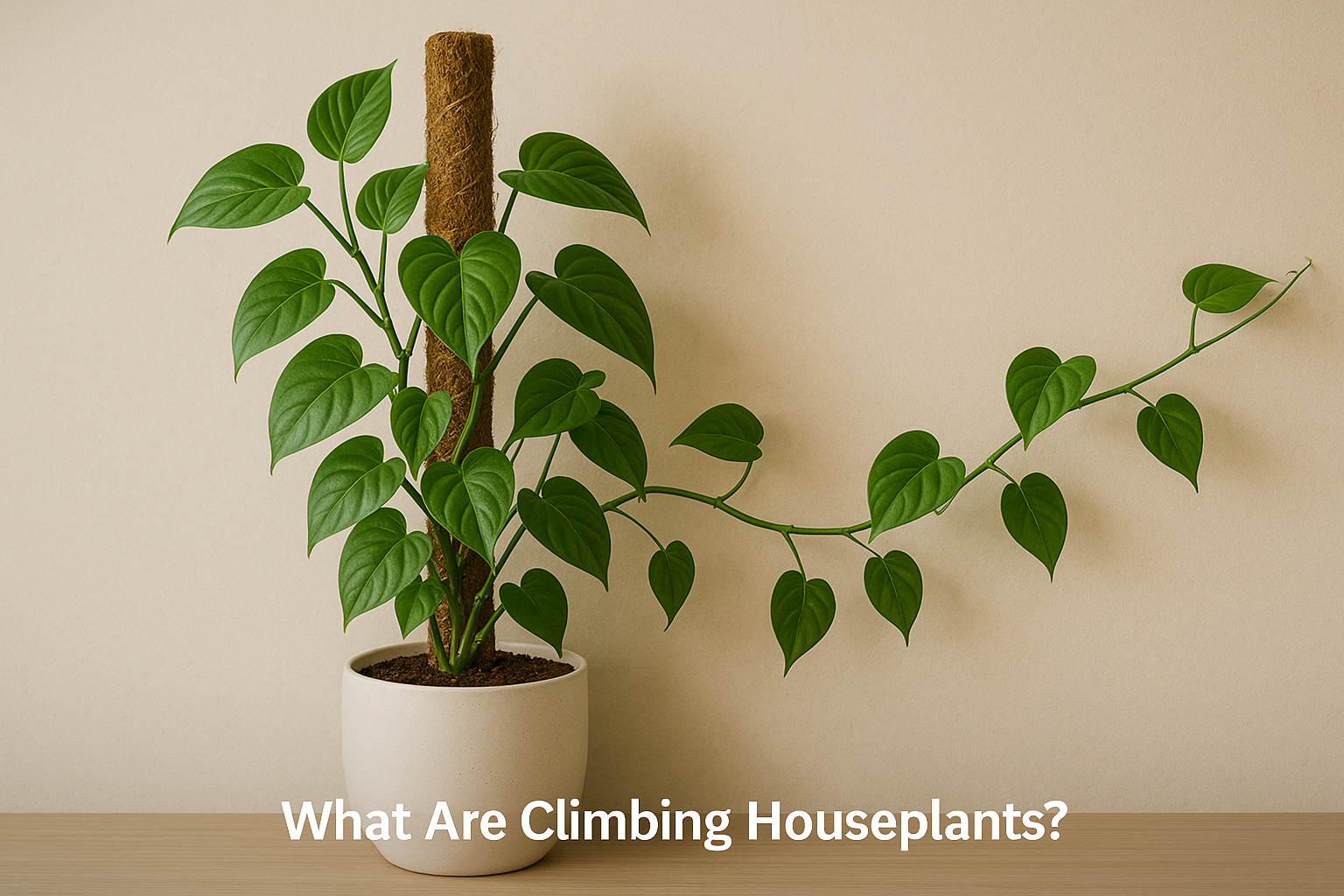
Climbing houseplants grow upward instead of outward. They use walls, sticks, wires, or furniture to rise or spread. These plants do not sit low like bushes. They stretch toward light. Some twist around poles. Others send thin arms that grip nearby surfaces. A few lean close to whatever gives support.
You can guide these plants into many shapes. Use hooks, cords, or mesh frames. Some vines follow straight lines. Others form curves, loops, or spirals. You can also let them drop down from hanging pots. These green trails turn empty corners into peaceful spots.
Climbing plants help in small homes. They grow up, not out. You save space without losing beauty. You do not need big pots or open floors. A wall near a window works fine. These plants also hide flaws like cracks or stains on walls.
Fast growers give quick results. One week shows new shoots. Another brings fresh leaves. In a short time, your space feels full of life. That makes these plants rewarding and easy to care for.
Common indoor climbers include pothos, ivy, philodendron, hoya, jasmine, and monstera. Each has its own shape and color. Some leaves look like hearts. Others split or shine. Some show silver, white, or yellow lines.
Every plant needs different care. Some love strong sunlight. Others do better in shade. Some want wet soil. Others prefer it dry. Some need steamy air. Others stay happy in normal rooms. Pick plants that match your home.
You can keep vines short or let them grow tall. Clip them to shape. Leave them wild for a bold look. You choose what fits your space. With good care, these plants make any room feel calm and alive.
Best Places to Grow Indoor Vines
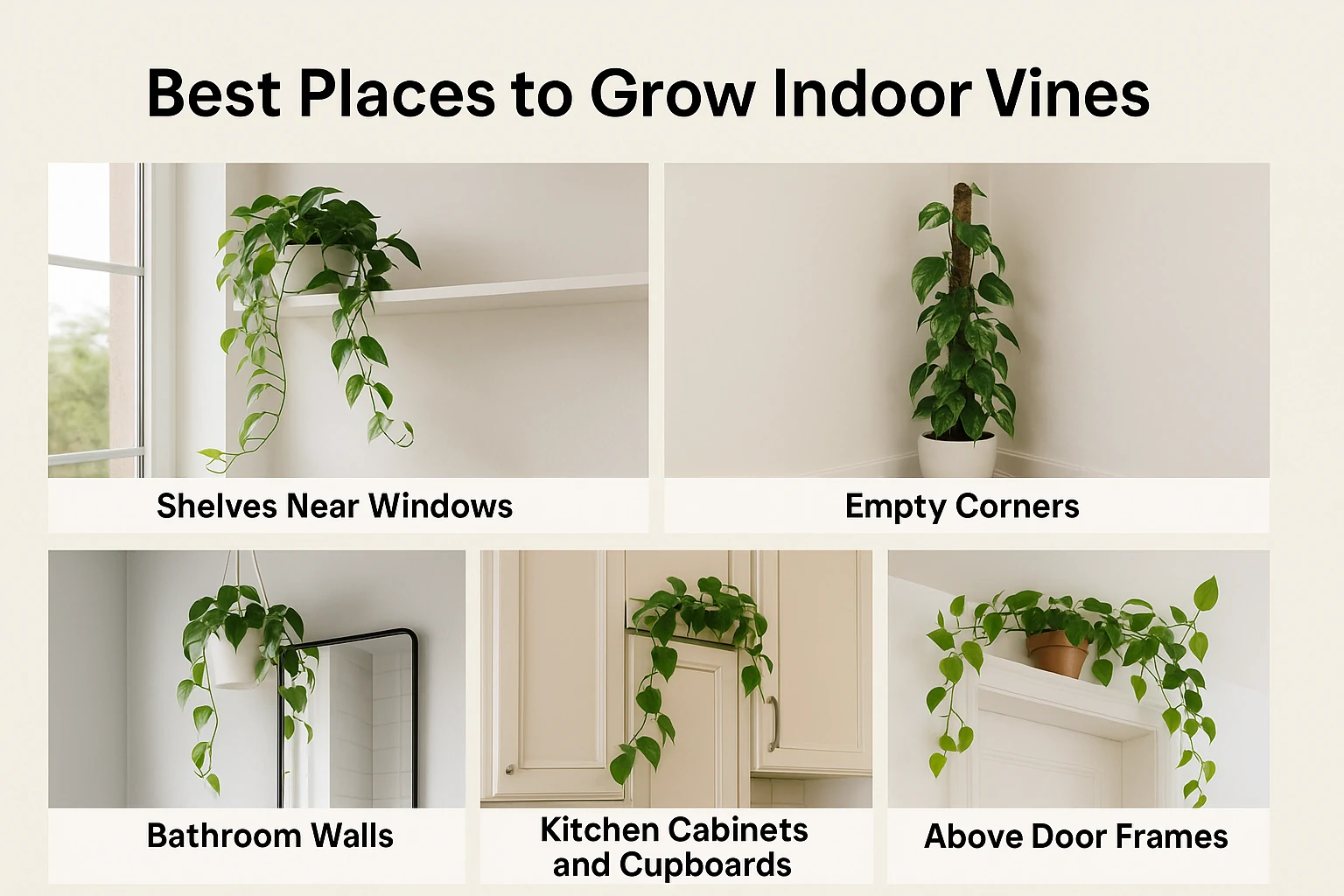
Shelves Near Windows
A sunny window ledge or open shelf gives climbing plants what they love-light and space. Place a small pot near the edge and let the vines spill down. The green curtain softens harsh lines and brings movement to the room. It draws the eye and makes the window feel fuller. This setup works well in living rooms, kitchens, or reading nooks. It brings calm without clutter.
Empty Corners
An unused corner is the perfect spot for a climbing plant. These spaces often look cold or forgotten. Add a moss pole, bamboo stick, or metal frame in the corner. Then train a fast-growing vine like pothos, philodendron, or monstera. As the plant climbs, it fills the gap with texture and life. The corner goes from dull to vibrant. This idea works best near natural light, but many vines also grow under strong indoor lights.
Bathroom Walls
Bathrooms stay warm and moist, which helps many tropical vines grow strong. If your bathroom gets even a little natural light, you can hang a plant near the mirror or shelf. Choose moisture-loving vines like heartleaf philodendron or pothos. Hang them from the ceiling or place them on high ledges. They soak in the steam and clean the air. The green leaves make the space feel like a spa. Your daily shower turns into a calm escape.
Kitchen Cabinets and Cupboards
Use the tops of cabinets as plant stands. Let vines trail down from cupboards or shelves. These green accents break up hard lines and add charm to plain cabinets. Just make sure the area gets some light. Avoid placing plants too close to heat sources like ovens or stovetops. Easy-care vines do well in this space with little fuss.
Above Door Frames
Few people use the space above a door, but vines love it. Place a pot on a high shelf or mount a hook for a hanging planter. Guide the vine across the top frame or down the side. This adds a surprise element to your room and fills the space without taking up floor or table space. It works best in entryways or narrow halls where space is tight.
Why Indoor Climbers Are So Popular

Indoor climbing plants do more than look nice. They bring calm, clean air, and a soft feel to any room. These plants help people relax. Many homes feel cold or busy. A few vines can fix that. They create peace and give comfort.
Green plants lift your mood. They help lower stress. Many studies support this. A single hanging plant near a window can change the space. A green wall draws the eye. It adds movement and balance. Vines stretch across shelves, fill corners, and soften sharp lines.
Climbers grow fast. You do not wait months to see growth. In just weeks, they start to climb. New leaves form quickly. One vine may wrap around a rod, another may reach toward light. This quick change brings joy. You feel proud watching your plant grow.
These plants need little space. They grow upward or downward. You can use a wall, a shelf, or a high corner. You do not need large pots. A small ledge or window sill can hold one. That makes them perfect for tight spaces, city flats, or small rooms.
Indoor vines come in many types. Some leaves are small and round. Others are large or shaped like hearts. Some show bold green. Others carry spots, stripes, or silver shades. You can mix colors and shapes. That adds style and life to the room.
Climbers match every look. They fit with wood, stone, glass, or metal. They work in soft, modern, or bright rooms. You can place them near bold art or plain walls. They blend with all themes. Their green tone works like a neutral color.
These plants do more than grow. They change how your home feels they turn still corners into soft spaces they bring freshness they make your home feel lived in and loved. People choose indoor climbers to add beauty and joy. They stay because these plants also add peace.
Are Climbing Plants Safe Indoors?
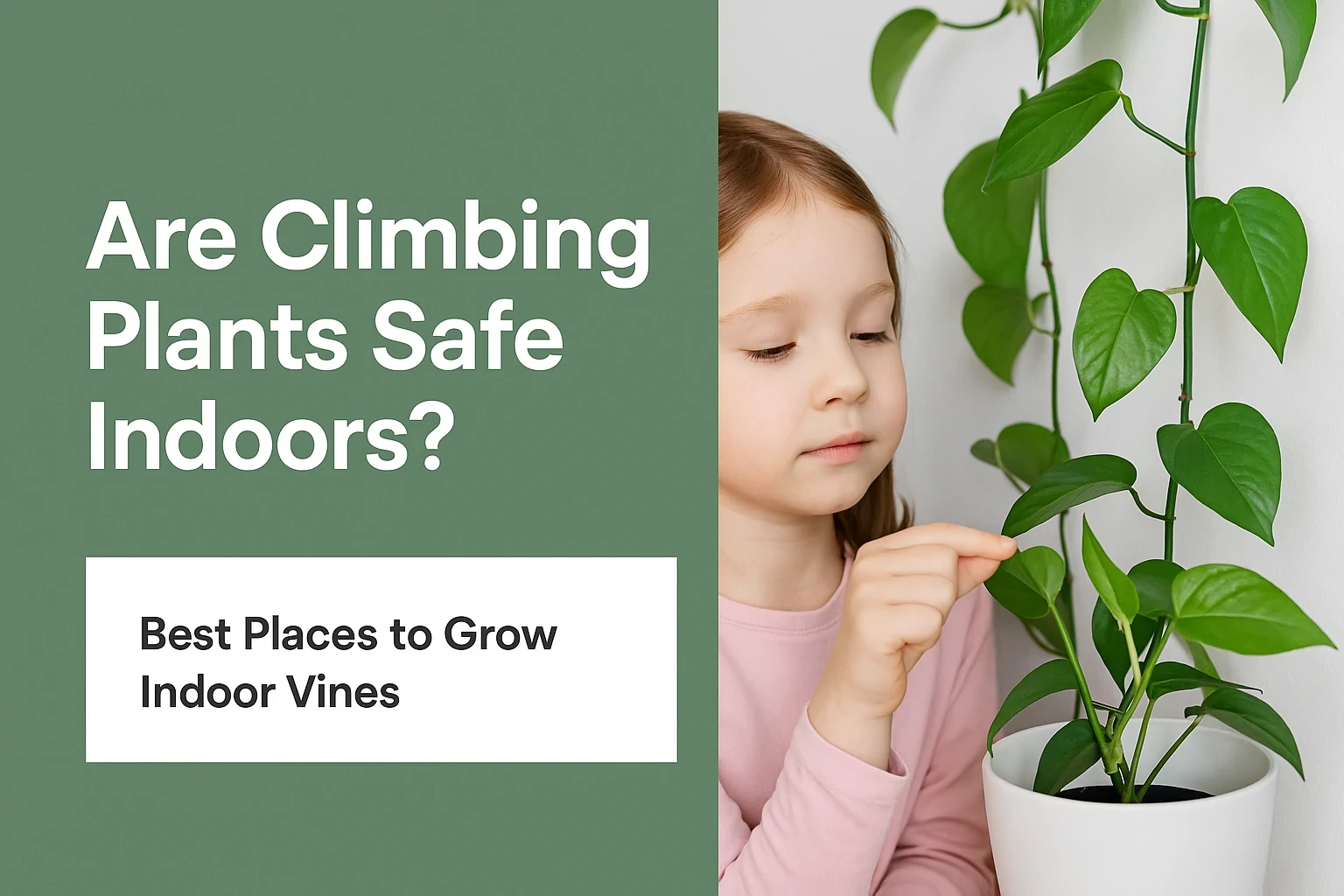
Climbing houseplants can be safe. But that depends on the plant you choose and where you place it. Some plants grow well without risk. Others may bring problems. You must think about safety before adding any plant to your space.
Some indoor climbers are safe for most homes. These include non-toxic types with soft leaves and little scent. They do not harm pets or children. They grow clean and smooth with little mess. But other plants may carry risks. Some vines hold sap that causes pain or rash. A few give off pollen or scents that may bother the nose or chest.
Pets and small children often explore with their mouths and hands. They may chew on leaves or pull on stems. This puts them at risk. Plants like pothos, philodendron, and English ivy can harm if touched or eaten. These plants contain a type of sap that may burn the skin, tongue, or eyes. A single bite may lead to drooling, pain, or upset stomach.
Some climbers can also fall or break things. If you use a weak hook or loose shelf, the plant may drop. Vines grow long and heavy. That weight may cause a pot to tip or a support to snap. This can hurt someone or damage the floor. Always use strong mounts. Pick pots with solid bases. Make sure every hanger or pole can hold the full weight.
Another risk is trapped moisture. Vines often grow thick. Their leaves block airflow. Wet soil and low light can lead to mold or pests. That affects the plant and the air you breathe. Some people get stuffy noses or itchy eyes. Others may face worse symptoms. People with asthma must stay extra careful.
To avoid these problems, choose plants with low risk. Look for those without strong scents or harmful sap. Keep plants away from pet zones or child play areas. Use open spots with fresh air. Clean the leaves now and then. Check for pests or rot often.
If you plan well, you can enjoy the beauty of vines without danger. A safe home still allows room for green growth. All it takes is smart setup, good care, and the right plant choice.
Many climbing plants are safe and easy to grow. These are great for homes with pets or children. Still, you should watch kids and pets around all plants.
Spider plants are a top choice. They trail like vines and grow well in hanging pots. They clean the air and cause little harm. Their long green leaves brighten any space.
Hoya plants are safe and strong. Their thick leaves hold water well. Their flowers smell sweet but do not cause reactions. You can guide them along a wire or let them hang freely.
Peperomia comes in many forms. Some types trail or climb gently. Most are non-toxic. Their small size and easy care make them a favorite.
Always check trusted plant safety lists. The ASPCA and RHS websites share updated information on plant safety for pets.
Climbing Plants to Handle With Care
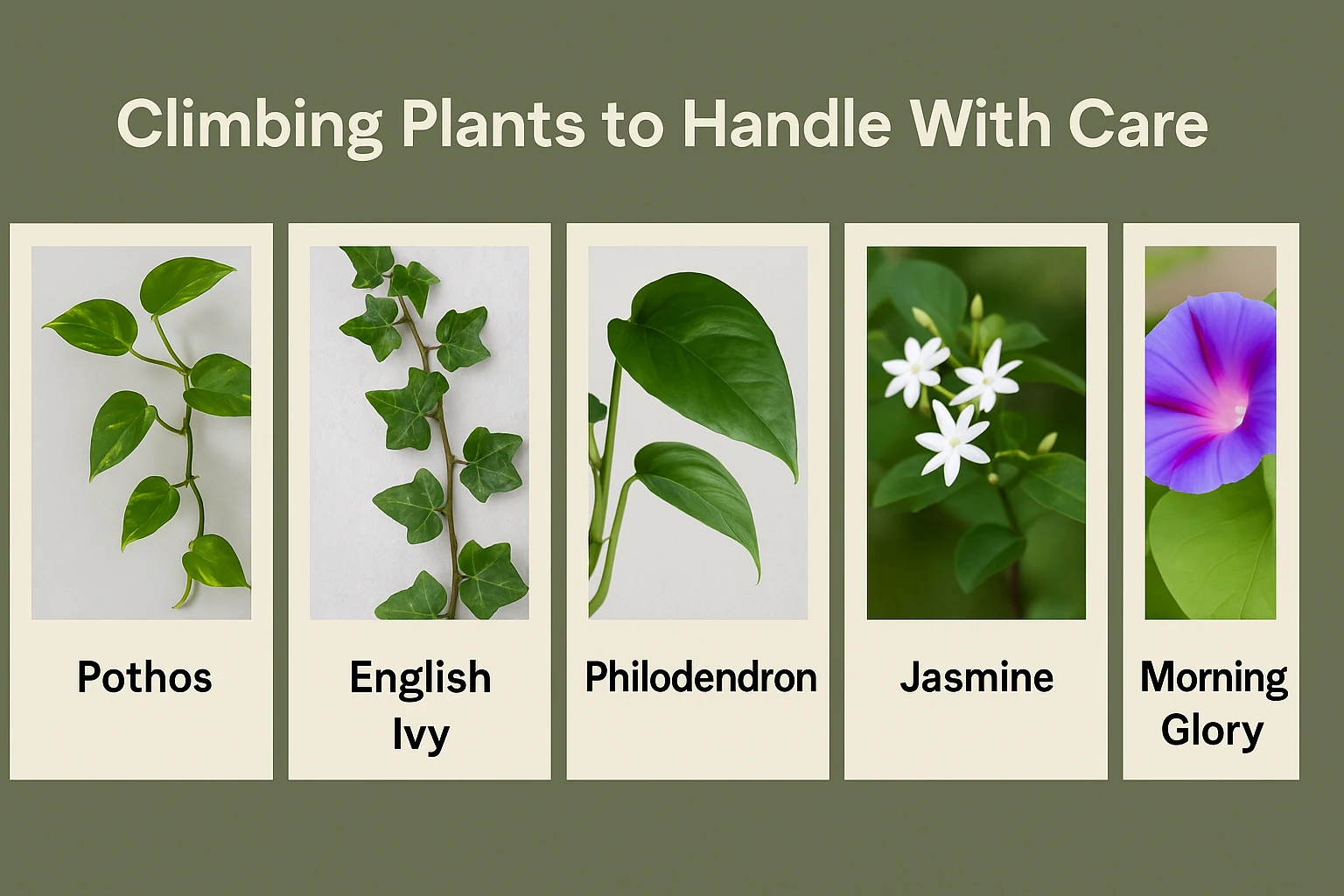
Some climbers may look nice but bring danger. Pothos is one of the most common indoor vines. But its sap is toxic to people and pets. If chewed or touched, it can cause pain or illness.
English ivy looks soft but hides danger. Its leaves may irritate skin or cause stomach problems if eaten. It spreads fast and needs regular trimming.
Philodendron has rich green leaves. But it contains harmful crystals that can burn the mouth or cause swelling. Most types are unsafe for pets.
Jasmine has a lovely scent, but not all types are safe. Some may cause allergic reactions. Others can upset pets’ stomachs.
Morning glory vines can be risky too. Their seeds contain strong chemicals. If swallowed, they may cause serious health issues.
If you grow these plants, keep them out of reach. Use hanging pots or high shelves. Add plant labels and let guests know which ones to avoid.
Signs Your Plant May Be a Problem
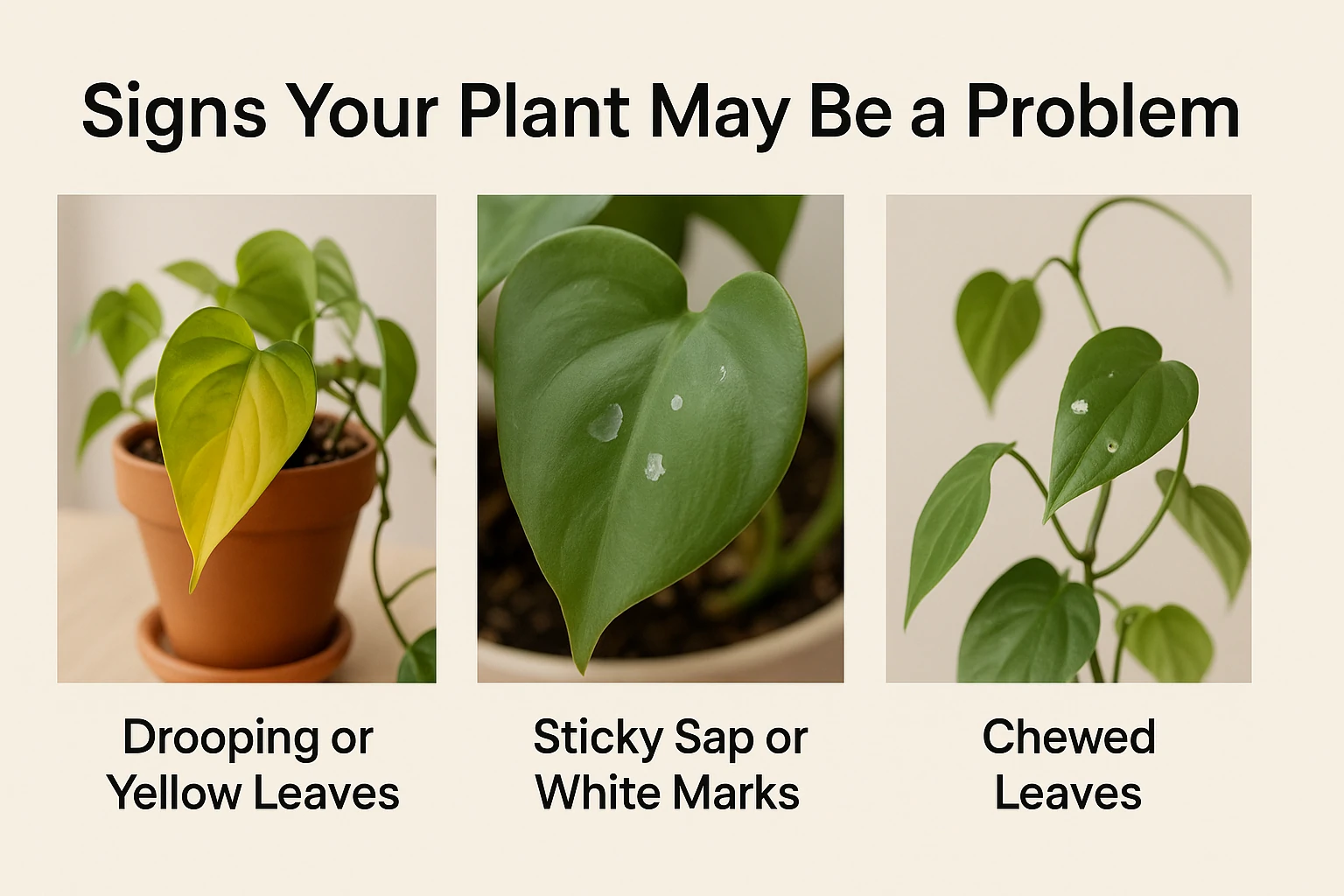
Drooping or Yellow Leaves
Leaves should look firm and full of life. When they droop or turn yellow, something is wrong. It could be dry roots, poor light, or trapped moisture. Sometimes, overwatering is the issue. Other times, dry air or cold drafts may stress the plant. These signs mean your plant is not happy. Fix the cause early. Check the soil, move the plant to better light, and trim damaged parts. A quick change can save it.
Sticky Sap or White Marks
Sticky spots on leaves or nearby surfaces often mean sap. Some climbing plants release sap that can be toxic or cause skin problems. You might also see white marks. These can come from pests like mealybugs or spider mites. These bugs harm leaves and spread fast. If you notice sap, spots, or a strange smell, wear gloves. Clean the plant and check safety guides. If it is on a toxic plant, move it out of reach.
Chewed Leaves
Bite marks, torn edges, or holes in the leaves may mean your pet has been exploring. This is more than just damage to the plant. Some plants, like pothos or philodendron, can harm your pet. Signs of chewing mean the plant may be a risk. Move it to a high spot. Hang it from the ceiling or place it on a tall shelf. You can also switch to a pet-safe option like a spider plant or peperomia.
How to Keep Climbing Plants Safe Indoors
Smart setup makes all the difference. Start by choosing the right spot. Keep vines away from walkways, pet zones, or play areas. Hang them high or let them climb near windows.
Use strong support. Vines that grow tall or wide need good structure. Use wall anchors, cages, or trellis frames. Make sure your setup holds the plant’s weight.
Use pots with drainage holes. That keeps roots from sitting in wet soil. Check for bugs or mold. Clean the leaves now and then to keep the plant healthy.
Cut back vines that grow too long. This prevents sagging and keeps the plant neat. Remove dead leaves or stems right away. That helps stop rot or disease.
Teach your family plant rules. Let children know not to touch or eat plants. Give pets safe grass or toys to distract them. Choose plants that match your space’s light and warmth.
If you enjoy caring for natural plants at home, explore our Philodendron Micans Care Guide to Growing Velvet Leaf Philodendron to learn how to grow a velvet-leaf plant that adds life and beauty to your space.
How to Choose the Right Climber for Your Space

Know Your Room
Start with the light. Some rooms get strong daylight all day. Others stay dim or cool. Each plant needs a certain kind of light. Pothos and philodendron do fine in low light. Hoya and monstera love bright, soft light. Do not guess. Watch your room for a day. See where light lands. This helps you choose plants that will grow, not struggle.
Also think about the air. Dry air from heaters can hurt some vines. Bathrooms or kitchens may stay humid, which helps certain climbers. Look around and match your plant to your space. Your room sets the rules.
Check Who Lives With You
Your home is more than walls. It holds people and pets. You must keep them safe. Some vines look pretty but can hurt a curious child or a chewing cat. Check before you buy. The ASPCA lists plants that are safe or toxic to animals. Spider plants and peperomia are good picks for pet homes. Avoid pothos and philodendron in spaces where kids or pets roam free.
You also need to think about habits. Kids may tug leaves. Dogs may jump on low shelves. Pick strong plants or put them out of reach. Safety and peace matter more than looks.
Keep It Simple
Not every home has time for high care. That is okay. Some plants need trimming, misting, and watching every day. Others grow strong on their own. Go for the easy ones first. Spider plants, hoya, and satin pothos do well without much work.
Choose vines that stay happy in your routine. If you travel a lot, pick low-water types. If you forget to trim, choose slow growers. The right plant fits your life, not the other way around. That makes plant care a joy, not a task.
Final Thoughts
Climbing houseplants bring new life to indoor spaces. They rise from shelves, stretch along walls, and fill bare spots with soft color. Even one healthy vine can turn a dull corner into a fresh and calm place. These plants do more than decorate. They lift your mood and make your home feel warm.
But not every plant fits every home. Some vines grow fast and wild. Some release sap that can harm. Others may break supports or drop leaves that pets eat. You must think before you choose. A smart setup leads to a safe, peaceful home.
The best indoor vines offer beauty with no risk. Spider plants, hoya, and peperomia grow strong and safe. They clean the air and stay easy to manage. You can place them in bright rooms or quiet corners. They work well with kids and pets nearby.
Some popular vines need more care. Pothos, ivy, and philodendron may cause health issues if touched or chewed. These plants still look great, but they must stay out of reach. Use firm hooks and stable pots. Make sure shelves can hold their weight.
Good care makes a big difference. Use safe spots with light and air. Wipe the leaves when they collect dust. Trim vines that grow too far. Watch the soil. Remove dry or yellow parts. These small steps help the plant grow strong and keep your space clean.
Indoor plants connect you to nature. They help you slow down they give your eyes a place to rest. They help you breathe better and feel calm. Green vines do not just look nice-they change how a home feels.
Pick plants that match your home and your life. Keep your setup simple and safe. Then watch the space come alive. With the right touch, your home will feel fresh, peaceful, and full of life.
If you enjoy natural ways to boost wellness, you can also read about Pravi Celer: The True Celery Root with Lasting Health Benefits to learn how this unique root supports long-term health.




